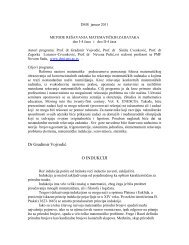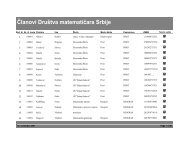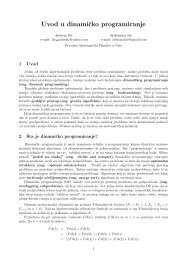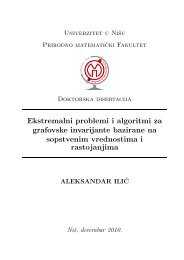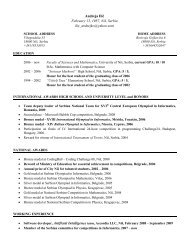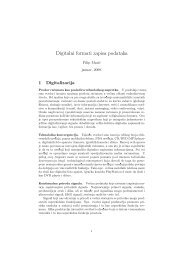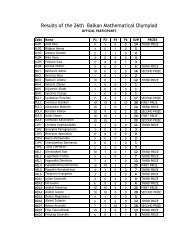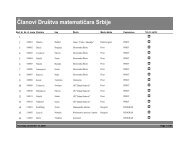Strukture podataka
Strukture podataka
Strukture podataka
- No tags were found...
You also want an ePaper? Increase the reach of your titles
YUMPU automatically turns print PDFs into web optimized ePapers that Google loves.
Pripreme za IOI 200806. avgust 2008. godinepredavač: Slobodan Mitroviće-mail: boba5555@gmail.com<strong>Strukture</strong> <strong>podataka</strong>Zadatak 1. [SPOJ Increasing Subsequences] Given a sequence of N(1 ≤ N ≤ 10, 000) integersS 1 , ..., S N (0 ≤ Si < 100, 000), compute the number of increasing subsequences of S with lengthK(1 ≤ K ≤ 50 and K ≤ N); that is, the number of K-tuples i 1 , ..., i K such that 1 ≤ i 1 < ... < i K ≤ Nand S i1 < ... < S iK .Input The first line contains the two integers N and K. The following N lines contain the integersof the sequence in order.Output Print a single integer representing the number of increasing subsequences of S of lengthK, modulo 5,000,000.InputOutput4 3 212210Zadatak 2. [SPOJ Distinct Increasing Subsequences] Given a sequence of N(1 ≤ N ≤ 10, 000)integers S 1 , ..., S N (0 ≤ S i < 1, 000, 000, 000), compute the number of distinct increasing subsequencesof S with length K(1 ≤ K ≤ 50 and K ≤ N).Input The first line contains the two integers N and K. The following N lines contain the integersof the sequence in order.Output Print a single integer representing the number of distinct increasing subsequences of S oflength K, modulo 5,000,000.InputOutput4 3 112210Zadatak 3. [SPOJ Intervals] You are given n closed integer intervals [a i , b i ] and n integers c 1 , ..., c n .Write a program that:• reads the number of intervals, their endpoints and integers c 1 , ..., c n from the standard input,1
• computes the minimal size of a set Z of integers which has at least c i common elements withinterval [a i , b i ], for each i = 1, 2, ..., n,• writes the answer to the standard output.Input The input begins with the integer t, the number of test cases. Then t test cases follow.For each test case the first line of the input contains an integer n(1 ≤ n ≤ 50000) - the numberof intervals. The following n lines describe the intervals. Line (i + 1) of the input contains three integersa i , b i and c i separated by single spaces and such that 0 ≤ a i ≤ b i ≤ 50000 and 1 ≤ c i ≤ b i −a i +1.Output For each test case the output contains exactly one integer equal to the minimal size ofset Z sharing at least c i elements with interval [a i , b i ], for each i = 1, 2, ..., n.InputOutput1 653 7 38 10 36 8 11 3 110 11 1Zadatak 4. [SPOJ Matrix Summation] A NxN matrix is filled with numbers. BuggyD is analyzingthe matrix, and he wants the sum of certain submatrices every now and then, so he wants asystem where he can get his results from a query. Also, the matrix is dynamic, and the value of anycell can be changed with a command in such a system.Assume that initially, all the cells of the matrix are filled with 0. Design such a system for BuggyD.Read the input format for further details.Input The first line of the input contains an integer t, the number of test cases. t test cases follow.The first line of each test case contains a single integer N(1 ≤ N ≤ 1024), denoting the size of thematrix.A list of commands follows, which will be in one of the following three formats (quotes are forclarity):• ”SET x y num” - Set the value at cell (x, y) to num(0 ≤ x, y < N).• ”SUM x1 y1 x2 y2” - Find and print the sum of the values in the rectangle from (x1, y1) to(x2, y2), inclusive. You may assume that x1 ≤ x2 and y1 ≤ y2, and that the result will fit in asigned 32-bit integer.• ”END” - Indicates the end of the test case.Output For each test case, output one line for the answer to each ”SUM” command. Print ablank line after each test case.2
InputOutput1 14 12SET 0 0 1 12SUM 0 0 3 3 13SET 2 2 12SUM 2 2 2 2SUM 2 2 3 3SUM 0 0 2 2ENDZadatak 5. [SPOJ Counting inversions] You are given a sequence A of N(N ≤ 250000) integersbetween 1 and 50000. On this sequence you have to apply M(M ≤ 10000) operations of the form:modify the i-th element in the sequence and then say how many inversions are there in the sequence.The number of inversions in a sequence is given by the number of pairs (i, j) with i < j and Ai > Aj.Input The first line of input contains the number N and the next line contains the numbers thatform the sequence. After that follows the number M and then M lines, each containig 2 integers Xand Y , meaning that new value of the X-th element of the sequence is Y and that you should countthe number of inversions in the modified sequence.Output Output must contain M lines, the i-th line of output containg the number of inversionsin the sequence after the first i operations.InputOutput10 172 6 6 4 7 6 3 5 9 1 187 168 8 135 1 145 6 810 5 67 110 104 6Zadatak 6. [Timus Factory] There are three machines on the new toy factory: A, B and C. Thefactory makes toys by processing each toy on these machines in order A, B, C. Your task is to createN toys as soon as possible. You know the time to process each toy on each machine: a i , b i and c i .You can select an arbitrary order of processing toys. The second machine is so fast that at least oneof the following two statements holds: max(b i ) ≤ min(a i ) or max(b i ) ≤ min(c i ).Input The first line of the input contains the number of toys N(1 ≤ N ≤ 100000). The next Nlines contain three integers each: a i , b i and c i (1 ≤ a i , b i , c i ≤ 1000000).Output Output the minimal possible processing time on the first line. The second line must containan example of optimal processing order a permutation of toy numbers from 1 to N.3
InputOutput5 333 1 6 2 1 3 5 41 1 25 2 57 1 410 2 81 165 4 7 1Zadatak 7. [USACO 2008 Februar GOLD - Hotel] The cows are journeying north to ThunderBay in Canada to gain cultural enrichment and enjoy a vacation on the sunny shores of Lake Superior.Bessie, ever the competent travel agent, has named the Bullmoose Hotel on famed Cumberland Streetas their vacation residence. This immense hotel has N(1 ≤ N ≤ 50, 000) rooms all located on thesame side of an extremely long hallway (all the better to see the lake, of course).The cows and other visitors arrive in groups of size D i (1 ≤ D i ≤ N) and approach the front deskto check in. Each group i requests a set of D i contiguous rooms from Canmuu, the moose staffing thecounter. He assigns them some set of consecutive room numbers r..r + D i−1 if they are available or,if no contiguous set of rooms is available, politely suggests alternate lodging. Canmuu always choosesthe value of r to be the smallest possible.Visitors also depart the hotel from groups of contiguous rooms. Checkout i has the parametersX i and D i which specify the vacating of rooms X i ..X i + D i−1 (1 ≤ X i ≤ N − D i+1 ). Some (or all) ofthose rooms might be empty before the checkout.Your job is to assist Canmuu by processing M(1 ≤ M < 50, 000) checkin/checkout requests. Thehotel is initially unoccupied.Input• Line 1: Two space-separated integers: N and M• Lines 2..M+1: Line i+1 contains request expressed as one of two possible formats: (a) Twospace separated integers representing a check-in request: 1 and D i (b) Three space-separatedintegers representing a check-out: 2, X i , and D iOutput Lines 1.....: For each check-in request, output a single line with a single integer r, the firstroom in the contiguous sequence of rooms to be occupied. If the request cannot be satisfied, output0.InputOutput10 6 11 3 41 3 71 3 01 3 52 5 51 6Zadatak 8. [IOI 2007 Sails] A new pirate sailing ship is being built. The ship has N masts (poles)divided into unit sized segments the height of a mast is equal to the number of its segments. Each4
mast is fitted with a number of sails and each sail exactly fits into one segment. Sails on one mastcan be arbitrarily distributed among different segments, but each segment can be fitted with at mostone sail.Different configurations of sails generate different amounts of thrust when exposed to the wind. Sailsin front of other sails at the same height get less wind and contribute less thrust. For each sail wedefine its inefficiency as the total number of sails that are behind this sail and at the same height.Note that ”in front of” and ”behind” relate to the orientation of the ship: in the figure below, ”infront of” means to the left, and ”behind” means to the right.The total inefficiency of a configuration is the sum of the inefficiencies of all individual sails.Write a program that, given the height and the number of sails on each of the N masts, determinesthe smallest possible total inefficiency.Input The first line of input contains an integer N(2 ≤ N ≤ 100000), the number of masts onthe ship. Each of the following N lines contains two integers H and K(1 ≤ H ≤ 100000, 1 ≤ K ≤ H),the height and the number of sails on the corresponding mast. Masts are given in order from the frontto the back of the ship.Output Output should consist of a single integer, the smallest possible total inefficiency.InputOutput6 103 25 34 12 14 33 2Zadatak 9. [USACO 2006 April GOLD - The Milk Queue] Every morning, Farmer John’sN(1 ≤ N ≤ 25, 000) cows all line up for milking. In an effort to streamline the milking process,FJ has designed a two-stage milking process where the line of cows progresses through two barns insequence, with milking taking part sequentially in both barns. Farmer John milks cows one by one asthey go through the first barn, and his trusty sidekick Farmer Rob milks the cows (in the same order)as they are released from the first barn and enter the second barn.5
Unfortunately, Farmer John’s insistence that the cows walk through both barns according to asingle ordering leads to some inefficiencies. For example, if Farmer John takes too long to milk aparticular cow, Farmer Rob might end up sitting idle with nothing to do for some time. On the otherhand, if Farmer John works too fast then we might end up with a long queue of cows waiting to enterthe second barn.Please help Farmer John decide on the best possible ordering of cows to use for the milking, sothat the last cow finishes milking as early as possible. For each cow i we know the time A(i) requiredfor milking in the first barn and the time B(i) required for milking in the second barn. Both A(i) andB(i) are in the range 1...20,000.Input• Line 1: A single integer, N.• Lines 2..1+N: Line i+1 contains two space-separated integers A(i) and B(i) for cow i.Output Line 1: The minimum possible time it takes to milk all the cows, if we order them optimally.InputOutput3 162 27 43 5Input details: There are three cows. Cow 1 takes 2 units of time in both barns, cow 2 takes 7units of time in the first barn and 4 in the second, and cow 3 takes 3 units of time in the first barnand 5 in the second.Output details: Ordering the cows in the order 3, 1, 2, will allow for milking to complete withinonly 16 units of time.Zadatak 10. [SPOJ Card Trick] The magician shuffles a small pack of cards, holds it face downand performs the following procedure:1. The top card is moved to the bottom of the pack. The new top card is dealt face up onto thetable. It is the Ace of Spades.2. Two cards are moved one at a time from the top to the bottom. The next card is dealt face uponto the table. It is the Two of Spades.3. Three cards are moved one at a time4. This goes on until the nth and last card turns out to be the n of Spades.This impressive trick works if the magician knows how to arrange the cards beforehand (and knowshow to give a false shuffle). Your program has to determine the initial order of the cards for a givennumber of cards, 1 ≤ n ≤ 20000.Input On the first line of the input is a single positive integer, telling the number of test casesto follow. Each case consists of one line containing the integer n.Output For each test case, output a line with the correct permutation of the values 1 to n, space6
separated. The first number showing the top card of the pack, etc...InputOutput2 2 1 4 34 3 1 4 5 25Zadatak 11. [Savezno Srbija Terorista] Najveća zgrada u svetskoj prestionici Beonisu ima Nspratova. Na svakom spratu se nalazi bazen. Terorista Joca želi da sruši zgradu, tako sto će porušitiprvi sprat, a samim tim i celu zgradu. Za svaki sprat su poznate sledeće informacije:• W i - težina vode koja se nalazi u bazenu na i-tom spratu na početku• L i - težina vode koju i-ti sprat može da izdrži• C i - cena dinamita potrebnog da se poruši i-ti spratSva voda iz srušenog sprata odlazi na sledeći niži. Ako težina vode na nekom spratu postane veća oddozvoljene koju može da izdrži, pod se ruši i sva voda prelazi nadole.Vas zadatak je da pomognete teroristi Joci da sa što manje novca sruši prvi sprat.Ulaz U prvom redu ulaza je prirodan broj N(1 ≤ N ≤ 100000), koji predstavlja broj spratova.U svakom od sledećih N redova nalaze se po tri cela broja W i , L i , C i (0 ≤ W i , L i , C i ≤ 2000000000),veličine naznačene u tekstu zadatka za i-ti sprat. Suma svih W i i C i za (1 ≤ i ≤ N) će uvek bitimanja od 2000000000.Izlaz Na standardni izlaz ispisati minimalnu količinu novca potrebnu da se banka potopi. Zatimu sledećih nekoliko redova upisati redne brojeve spratova koje treba srušiti za minimalno rešenje, uredosledu rušenja.UlazIzlaz4 510 50 100 30 100 3 2100 100 210 50 6Objašenjenje: Terorista ruši treći, pa drugi sprat sa minimalnom cenom 5. Drugi sprat se neruši sam, jer je težina vode nakon eksplozije jednaka trećini izdržljivosti. Kada bi se rušio samo prvisprat cena bi bila 100, a kada bi se rušio četvrti cena bi bila 6.Zadatak 12. [SPOJ Brackets] We will call a bracket word any word constructed out of twosorts of characters: the opening bracket ”(” and the closing bracket ”)”. Among these words we willdistinguish correct bracket expressions. These are such bracket words in which the brackets canbe matched into pairs such that• every pair consists of an opening bracket and a closing bracket appearing further in the bracketword• for every pair the part of the word between the brackets of this pair has equal number of openingand closing brackets7
On a bracket word one can do the following operations:• replacement – changes the i-th bracket into the opposite one• check – if the word is a correct bracket expressionWrite a program which• reads (from standard input) the bracket word and the sequence of operations performed,• for every check operation determines if the current bracket word is a correct bracket expression,• writes out the outcome (to standard output).Input Ten test cases (given one under another, you have to process all!). Each of the test cases is aseries of lines. The first line of a test consists of a single number n(1 ≤ n ≤ 30000) denoting the lengthof the bracket word. The second line consists of n brackets, not separated by any spaces. The thirdline consists of a single number m – the number of operations. Each of the following m lines carriesa number k denoting the operation performed. k = 0 denotes the check operation, k > 0 denotesreplacement of k-th bracket by the opposite.Output For every test case your program should print a line:Test i:where i is replaced by the number of the test and in the following lines, for every check operation inthe i-th test your program should print a line with the word YES, if the current bracket word is acorrect bracket expression, and a line with a word NO otherwise. (There should be as many lines ascheck operations in the test.)InputOutput4 Test 1:()(( YES4 NO4 and 9 test cases more020and 9 test cases more8



